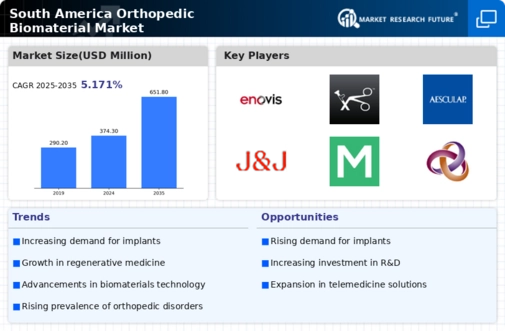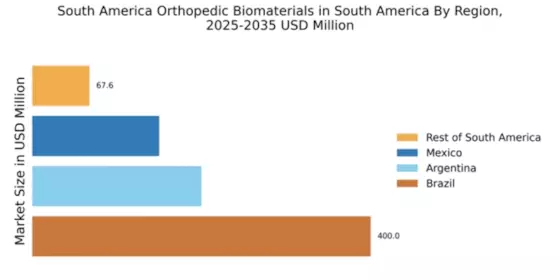The orthopedic biomaterial market in South America is characterized by a dynamic competitive landscape, driven by increasing demand for advanced surgical solutions and a growing aging population. Key players such as DePuy Synthes (US), Stryker (US), and Zimmer Biomet (US) are at the forefront, focusing on innovation and regional expansion to enhance their market presence. These companies are strategically positioned to leverage technological advancements and partnerships, which collectively shape a competitive environment that is increasingly focused on quality and efficacy in biomaterials.
In terms of business tactics, companies are localizing manufacturing to reduce costs and improve supply chain efficiency. The market appears moderately fragmented, with several players vying for market share. However, the influence of major companies is significant, as they set industry standards and drive innovation. This competitive structure suggests that while there is room for smaller players, the dominance of established firms is likely to continue shaping market dynamics.
In October 2025, Stryker (US) announced the launch of a new line of biodegradable orthopedic implants designed to enhance patient recovery times. This strategic move is indicative of Stryker's commitment to innovation and sustainability, aligning with current trends towards environmentally friendly medical solutions. The introduction of these implants could potentially reshape surgical practices in the region, offering a competitive edge in a market increasingly focused on patient outcomes.
In September 2025, Zimmer Biomet (US) expanded its partnership with a local South American distributor to enhance its supply chain capabilities. This action reflects a strategic focus on regional accessibility and responsiveness to market demands. By strengthening its distribution network, Zimmer Biomet aims to improve its service delivery and customer engagement, which may lead to increased market penetration and customer loyalty.
In August 2025, DePuy Synthes (US) unveiled a new digital platform aimed at streamlining the surgical planning process for orthopedic procedures. This initiative highlights the growing trend of digital transformation within the industry, as companies seek to integrate technology into their operations. The platform is expected to enhance surgical precision and improve patient outcomes, thereby reinforcing DePuy Synthes's competitive position in the market.
As of November 2025, current trends in the orthopedic biomaterial market include a strong emphasis on digitalization, sustainability, and the integration of artificial intelligence (AI) in product development. Strategic alliances are increasingly shaping the landscape, as companies collaborate to enhance their technological capabilities and market reach. Looking ahead, competitive differentiation is likely to evolve from traditional price-based competition to a focus on innovation, advanced technology, and reliable supply chains, suggesting a transformative shift in how companies position themselves in the market.


















Leave a Comment